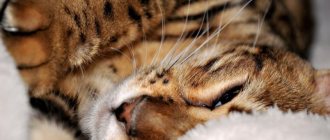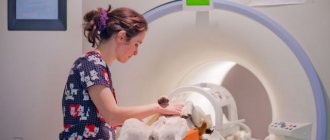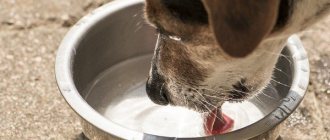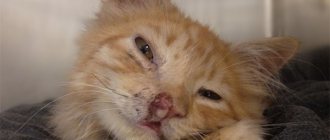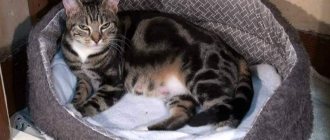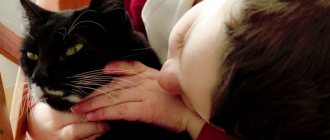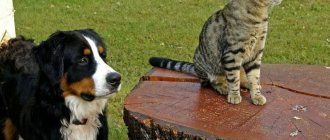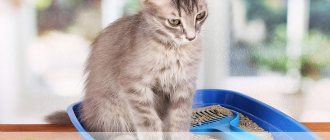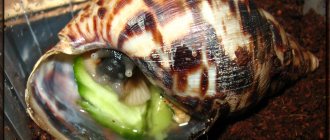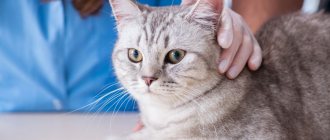Responsible owners always monitor the living conditions of their pets, so any oddities in behavior do not go unnoticed. It is very important to maintain a constant amount of food, water and vitamins. This is the only way the pet will remain healthy. That is why, when it is discovered that a cat drinks a lot of water, you need to quickly identify the cause and regulate the animal’s regime.
About the norm
Changing your pet's needs is not always a bad thing! Therefore, there is no need to panic if your cat drinks a lot of water. The reason may be completely harmless, and the consequences of changing the drinking regime will not affect the animal’s well-being at all. Felinologists do not have a definite figure for mandatory water consumption - this number depends on nutrition, climate, breed, age and many other factors.
Attention! Do not try to force water on a healthy cat! With rude actions you will not only not achieve the desired result, but will also frighten your pet. The animal, as a rule, knows very well how much water it needs!
Typically, veterinarians advise calculating the amount of required moisture so that there is 0.03 milliliters of liquid per gram of pet’s body weight. It doesn’t have to be just water; milk, canned food, and wet food will do.
It is very important to pay attention to your pet's diet. If a cat drinks a lot of water, the reasons may lie solely in a change in diet. Dry food tends to “pull” moisture from the animal’s body. Because of this, it is recommended to equalize the amount of water to the weight of food in a ratio of 1:3.
Symptoms: thirst + illness
If a cat drinks a lot and refuses to eat (eats little), you can suspect:
- hyperthermia;
- pyometra;
- intoxication;
- neoplasms of malignant origin;
- oral diseases;
- diarrhea (dehydration).
Large water consumption and excessive urination occur with endocrine diseases, kidney failure or liver pathologies. If the pet’s age is more than 8 years, then one can suspect oncology, metabolic disorders, kidney (liver) disease, and dehydration of various origins.
Diseases
Diabetes mellitus in a pet is one of the diseases that causes constant thirst. The cat's pancreas stops producing the required amount of the hormone insulin, which leads to problems delivering glucose to the cells. The necessary substance does not reach the kidneys in sufficient quantities. An important organ cannot filter moisture properly, and the cat quickly loses water.
Chronic renal failure is a very common incurable disease in older animals. Cells in an important organ cease to function normally and retain the required amount of moisture.
If your cat drinks a lot of water, then it is likely that you are experiencing one of the symptoms of hepatitis. The disease is caused by inflammatory processes in the liver. With proper treatment, the problem can be quite easily dealt with.
Attention! Many viral diseases and inflammatory processes are accompanied by increased thirst. Try to provide your pet with enough water so that his body continues to fight the disease.
Insulinoma (that is, inflammation of the pet's pancreas) is also accompanied by the fact that the cat often drinks water. The reasons for increased thirst also lie in excess insulin production. It is extremely rare in cats.
Food poisoning
If the cat is lethargic, has stopped eating, and is constantly vomiting, the reason is obvious - severe food poisoning.
How an animal can be poisoned:
- Stale food – be sure to monitor your pets’ diet. After each meal, it is recommended to throw away the remaining portion and leave the bowl clean. In a warm environment, destructive microorganisms quickly develop - the causes of frequent poisoning.
- Household chemicals - for example, leftover dishwashing liquid. It is necessary to rinse the bowl thoroughly under running water after each wash.
- Medicines - in the instructions for use of each drug, the dosage is clearly calculated in accordance with the weight and age of the animal. Exceeding the permissible limit is very dangerous.
- Vapors of paints and other chemicals - during repairs or work with strong-smelling substances, the animal should be kept away. This way you will protect him from poisoning and preserve his sense of smell.
What to do in case of poisoning? Give plenty of fluids and liquid food - weak broths, weak porridges, slightly diluted fermented milk products.
It is quite possible that the cat will not want to eat. Try to feed her at least in very small portions - this way toxic substances will be eliminated faster when going to the toilet.
Natural causes
Often, owners, asking the question “Why does the cat drink a lot of water?”, unnecessarily dramatize the situation. Don’t forget about the completely natural (and harmless!) reasons for your pet’s increased need for water:
- increased physical activity (long walks, hyperactivity, playfulness, training);
- increased room temperature, stuffiness, hot season;
- pregnancy or lactation period;
- age (kittens practically do not need additional moisture, and older animals drink a lot);
- dietary habits (dry food or salted foods).
Don't worry or worry too much. If there are no other alarming symptoms in your pet’s behavior, then you just need to give your pet a little more water than usual.
Attention! It is necessary that the water in the drinking bowl is always fresh (changed every day). Do not give your pet tap water or distilled water. It is recommended to leave the filtered or boiled liquid in a bowl in a visible place. The pet must have free access to it.
Vomiting in a cat - poisoning and more
In addition to the first version that comes to mind, that the cat was poisoned, there are a number of other reasons for the malaise.
The most important thing to note is severe overeating. If an animal has been hungry for a long time and then eats a lot, the stomach does not have time to cope with the load
Excess food is eliminated naturally.
Animals can independently regulate vomiting processes, relieving themselves of the feeling of heaviness and discomfort in the abdomen.
If the food was eaten too quickly, it is possible that the walls of the esophagus were strongly irritated by something, which also led to vomiting.
Be sure to monitor your pet's diet. Feeding foods that are difficult and take a long time to digest creates additional problems with the gastrointestinal tract. If you feed your cat dry food, it may be worth switching to a different one.
Recommendations for improving the condition:
- Analyze what the animal has eaten recently. Perhaps the condition was affected by a new product or food that had not been introduced into food before.
- For constipation combined with vomiting, give an enema. Toxins accumulated in the body will be eliminated faster.
- Cats with long, thick hair require thorough brushing every day. It is very likely that the cause is wool stuck in the stomach.
https://youtube.com/watch?v=csVXHEvFsI8
Other reasons
However, it also happens that none of the listed reasons are suitable. Then the owners do not understand why the cat drinks a lot of water, what it means and how to treat it. Among these reasons are:
- increased sweating;
- taking special medications (diuretics, corticosteroids, sometimes due to side effects of sedatives or painkillers);
- loose stools;
- discharge from the genitals;
- dropsy (a disease characterized by the accumulation of fluid in the cavities and tissues of the body);
- stress and mental disorders;
- brain pathologies.
If you notice that your pet is drinking much more water than usual, you should first conduct a home examination, and then (if there is no harmless explanation) contact your veterinarian!
What should the owner do?
The best thing is to call a veterinarian at the RosVet VC to your home and voice the problem. If the cat’s condition is stable, you can bring it to the clinic for examination by making an appointment by phone: +7.
Prepare an anamnesis (history), share observations about why it became noticeable that the cat drinks a lot, what other symptoms accompanied the increase in thirst. All this will facilitate the diagnosis of possible internal pathologies and allow the specialist to quickly prescribe treatment (if necessary).
When the alarm turns out to be false and excessive water consumption was caused by heat, physical activity or stress, the cat can be taken home with the advice of a veterinarian.
If you are concerned about your cat’s condition, don’t hesitate! The RosVet clinic receives visitors 24 hours a day. For any questions, you can contact us in advance by phone: +7 (495) 256-11-11, 24 hours a day.
Diabetes
Cats, like people, have elevated blood sugar levels. This does not occur too often, but such a disease requires increased attention and timely treatment.
Reasons: monotonous, poor nutrition and lack of exercise. Diabetes most often affects animals whose activity is limited to the walls of a city apartment. You should watch neutered cats especially carefully - their pancreas function is often impaired due to excess weight.
Treatment of diabetes is a very complex and painstaking process, so not all owners are ready for it. Some prefer not to torture the animal, but to euthanize it.
If the diagnosis is confirmed by a specialist, then long-term treatment begins. It includes insulin injections and a special diet. You constantly need to measure your sugar level (about once every 2-3 hours). So the doctor prescribes an individual dosage and course of therapy.
If the measures prescribed by the doctor are followed, the cat can fully recover and live a long, fulfilling life.
Signs of dehydration
Experiments with bowls do not always bring results immediately, and the cat continues to be mischievous. This behavior threatens dehydration and the acquisition of unpleasant diseases.
A small test can help identify dehydration in a cat. Pull back the skin on the cat's neck and watch it return to its original position. If this happens quickly, your pet is fine.
If the fold of skin is difficult to pull back, and then it slowly straightens, the cat is dehydrated. If there are other alarming symptoms, the animal must be immediately shown to a veterinarian.
Diagnostics
One of the first diagnostic methods is to take a blood test, which determines the presence of inflammation, anemia and altered red blood cells. It is also necessary to take a biochemical analysis to determine liver enzymes (ALT, AST and alkaline phosphatase). The level of direct and total bilirubin is also assessed.
Normal indicators in cats: ALT – from 19 to 78 units/l, AST – from 9 to 30 units/l, Bilirubin – from 2 to 16 µmol/l
A urine test also evaluates the presence of bilirubin and urobilinogen.
Blood smears are performed to determine parasites, as well as serological tests for feline immunodeficiency viruses, leukemia and leptospirosis.
If effusion or ascites is present, fluid analysis is performed.
To examine the liver, ultrasound is used, as well as radiography - it determines the presence of fluid, enlargement of the liver or spleen, as well as metastases or tumors.
Sometimes it is necessary to perform a liver biopsy and bile collection for bacteriological and cytological analysis.
For prehepatic jaundice, a blood clotting test (prothrombin index), an immune-mediated hemolytic anemia test, and a water-salt test (to determine the agglutination (clumping) of red blood cells) are performed.
How to get a cat to drink water?
How to get a cat to drink clean water that does not flow from the tap? Here are some rules.
- Do not place a bowl of water near food. Some owners even place it in another room.
- You can put not one bowl, but several. Then the cat will see them and remember that he needs to drink.
- Try using a deep transparent bowl. Cats are a fan of these containers.
- Change the water 1-2 times a day. Stagnant water begins to smell unpleasant and loses its taste. Cats drink it extremely reluctantly.
- A ceramic water container is ideal. In second place is glass. The third is stainless steel. The worst option is non-toxic plastic containers. This option comes in last place, because... plastic has wide pores where bacteria become clogged. As a result of the constant exposure of these bacteria to the oral mucosa, some cats develop acne and eosinophilic granuloma.
- The best solution is to buy a special fountain for cats. It creates the effect of running water, so representatives of the cat family enjoy drinking from such devices. In addition, the liquid, as it circulates, is further purified through filters and enriched with oxygen. In this case, the pet will consume more water, which is an excellent prevention of many diseases.
Rate and share!
